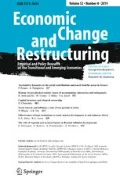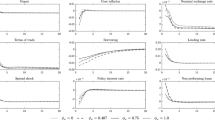Abstract
This paper presents a quarterly macro econometric model of Kazakhstan. The main goal is to provide a stylized representation of the Kazakh economy in order to simulate the consequences of several economic policies viewed by the authorities as essential during the period of transition to a market economy. The policy simulation potential of the model is illustrated by five types of simulations: interest rate shocks, foreign direct investment shocks, world oil price shocks, foreign demand shocks and nominal wages shocks. These sets of simulations show the importance of foreign direct investments in terms of theirs global positive effect, as well as the demand effect of an increase in the wages. We also find that effect of the tight monetary policy is not unambiguous; we argue that in some cases it is not the most efficient policy instrument to sustain the economy.



Similar content being viewed by others
Notes
t-ratios are shown in parentheses.
The model is solved with the nominal variables. Then, the endogenous variables are expressed in real terms.
References
Berg A, Borensztein E, Sahay R, Zettelmyer J (1999) The evolution of output in transition economies: explaining the differences. International monetary fund working paper no 9973
Brown RL, Durbin J, Evans JM (1975) Techniques for testing the constancy of regression relationships over time. J Roy Statist Soc B 149–162
Falcetti E, Raiser M, Sanfey P (2000) Defying the odds: initial conditions, reforms and growth in the first decade of transition. London School of Economics working paper, May 2000
Fischer S, Sahay R (2000) The transition economies after ten years. National Bureau of Economic Research working paper no 7664
Havrylyshyn O, van Rooden R (2000) Institutions matter in transition, but so do policies. International Monetary Fund, European II Department, 26 pp
Havrylyshyn O, Izvorski I, van Rooden R (1998) Recovery and growth in transition economies 1990–98: a stylized regression analysis. International monetary fund working paper no 98–141
IMF (2011) Republic of Kazakhstan: selected issues, countries report no 11/150 and 151, Washington DC
Jensen J, Tarr D (2007) The impact of Kazakhstan’s accession to the World Trade Organization: a quantitative assessment. World Bank Policy Research Paper, World Bank, Washington DC
Medas P (2003) The non-oil sector in Kazakhstan: links with the oil industry and contribution to growth, in Republic of Kazakhstan: selected issues and statistical appendix. International monetary fund country report no 03-211
Pesaran MH, Shin Y, Smith RJ (2001) Bounds testing approaches to the analysis of level relationships. J Appl Econom 16:289–326
Ramamurthy S, Tandberg E (2002) Treasury reform in Kazakhstan: lessons for other countries. International monetary fund working paper no 02-129
Wyplosz C (2000) The ten years of transformation: macroeconomic lessons. CEPR discussion paper, no 2254
Author information
Authors and Affiliations
Corresponding author
Appendices
Appendix 1
See Table 2.
Appendix 2: Results of simulations
Appendix 3: Stability tests outcomes
3.1 Real consumption equation
3.2 Investment rate equation
3.3 Real exports equation
3.4 Real imports equation
3.5 Changes in inventories equation
3.6 Real government expenditures equation
3.7 Employment equation
3.8 Productivity equation
3.9 Real wages equation
3.10 Consumer prices equation
3.11 Producer prices equation
3.12 Interest rate equation
3.13 Nominal exchange rate equation
Rights and permissions
About this article
Cite this article
Dufrenot, G., Ospanova, A. & Sand-Zantman, A. A small macro econometric model for Kazakhstan: a retrospective of alternative economic policies undertaken during the transition process. Econ Change Restruct 47, 1–39 (2014). https://doi.org/10.1007/s10644-012-9126-3
Received:
Accepted:
Published:
Issue Date:
DOI: https://doi.org/10.1007/s10644-012-9126-3













































